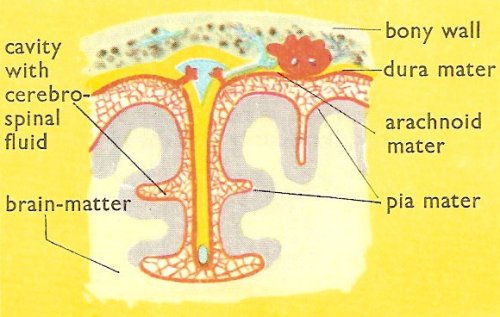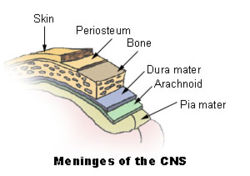meninges

Neither the brain nor the spinal cord directly touches the bones of the skull or spine. They are wrapped in three membranes called meninges.

Another cross-sectional view of the meninges.
The meninges are any of three continuous sheets of connective tissue which cover the spinal cord and the brain. From the outside in, they are:
The dura mater, a very tough white fibrous tissue that is pressed against, and sticks to, the bony surface of the interior of the vertebrae and the cranium of the skull.
The arachnoid, a thin layer resembling a cobweb with numerous threadlike strands attaching it to the innermost layer. The space under the arachnoid, the subarachnoid space, is filled with cerebrospinal fluid and contains blood vessels.
The pia mater, the innermost layer of meninges. This thin, delicate membrane is tightly bound to the surface of the brain and spinal cord and cannot be dissected away without damaging the surface. From it, numerous small blood vessels pass into the nerve tissue.
The arachnoid and pia mater collectively are known as the leptomeninges; leptomeningitis is inflammation of the arachnoid and pia mater (see meningitis).
Meningiomas
Meningiomas are tumors of the nerve tissue covering the brain and spinal cord. Although meningiomas are unlikely to spread, physicians often treat them as though they were malignant because symptoms may develop when a tumor applies pressure to the brain.


